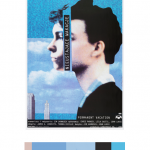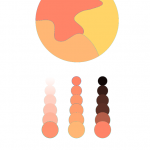This was the final project for our course. Fusing together all the skills aquired and learned, we were to create book covers for our humument books. In refrence to a work of art located in the Cooper Hewitt museum, humument books used proportional color schemes to crate a holistic harmony between color and composition. The themes of my book are wonder and fantasy. Because of that i chose a work of art that uses various tints of blue. Emitting a feeling of peacefulness and dreams, this was the perfect inspiration for my book. I used question marks in my book cover design because wonder is often associated questions. Another reason is because when someone is aware of dreaming there is often a question between what’s real and whats not. This relates to my book which deals with various memories of fantasies and dreams. Because they are memories (remembrances) there can be a question of what truly did and did not happen. Overall, this project was learning to create balance using every skill in our tool box, even those of English. Its one thing to have the skills but another to apply them harmoniously.
Author: Marcus
persistent
Persistent /pərˈsist(ə)nt/ – to be consistently strong despite difficulties; to not give up
Ex. Although Stanley procrastinated a bit this semester, he is persistent to complete all his work.
I remember hearing of this word back in september when we spoke about ourselves. I honestly heard it before but had no clue what so ever as to what it actually meant
contiguous
Contiguous /kənˈtiɡyo͞oəs/ – to be close in distance, side by side; to touch borders.
Ex. New jersey and Pennsylvania are considered contiguous states because their borders touch.
In my illustrator class, my teacher used this term when explaining selection methods. The word has a weird sound and could have meant anything so i decided to search it up and add it to our class glossary.
perilous
Perilous /ˈperələs/ – to be filled with danger. Not safe.
Ex. After 9/11, New York city became perilous causing there to be an upgrade in security
A professor in my class used the term. I’m familiar with it because of the Star spangled banner but never truly understood it.
lenient
Lenient /ˈlēnēənt/ – to be forgiving or permissive.
Ex. “Sam became lenient after I apologized for breaking her book. She smiled and gave me a hug.”
I’ve come across this term countless times throughout my time being. I’ve had a sense of the word but didnt really know what it actually meant. Turns out to be the oppisite of what I thought it was.
Color harmony: Phase 3

For this phase of the project, we visit the Cooper Hewitt museum as a class trip. Here we explored many fields of art from graphics, sculptures, textiles, motion graphics, architecture, and so on. We were to use an inspiring piece of art found in the museum that also fit our selected theme for our humument books. My book in specific talks about a journey and I am juxtaposing that with the theme of memories. There is a relation but big difference between a journey and a memory. While on journey, a person’s experience is physical and fruitful. A memory on the other hand is a mental experience which we feel emotionally not physically. I also chose to articulate various memories of people from different walks of life to emphasize the differential between people. My book on the other hand shows how people can sometimes be all connected. I chose this as reference for my color inventory because when I first looked at it my mind suddenly became clear and peaceful. The peacefulness perceived from the blue allowed my mind to relax and reminisce. I’ve learned different shades, tints of blue can emit different emotions and this blue specifically gives a tranquil, relaxed state of mind. Although it’s peaceful the feeling of assurance is also provided. This part took me about 2 hours 20 mins.
Color harmony: Phase 2


The Analagous color pallete on top displays Analagous colors. These are colors that lie adjent to one another on the color wheel. For example you want the color green. You’ll then chose one color after and before green which are green blue and yellow green. That leaves you with Green, green blue, and yellow green. Together those colors will work harmoniously and that is a strategy in choosing colors. For My analagous pallete I decided to stick with muted warm colors. To be more specific I have a muted red-orange, orange and yellow-orange mashup in my composition. Under my composition I show an example of tint on the left, a two color gradient in the middle and shade on the right.
For split complementray colors you take one color and use the two colors adjacent to its compliment. An example is Violet, then find it’s compliment (yellow). The colors that come before and after yellow are orange and green. That means violet, orange, and green work harmoniously as a split complimentary color pallete. This composition contains muted colors aswell. Colors are muted with white leaving tinted red violet, blue and yellow. Below my composition, you see three examples, the left showing shade, the right showing tint and the middle showing a two color gradient. I did both compositions using Adobe Color CC Program. In total I spent around 2 hours.
Exhibit Catalogue: final
Inspired by Tom Phillips’ humument, New York city artist, Marcus Ceron creates Wonderfilled using old material. By Re-configuring Brian Zelzack’s Wonderstruck, Ceron juxtaposes the themes of realism and fantasy. Juxtapositions are observed through a novel that discusses realistic journeys and through poems exploring copious impossibilities . Wonderstruck also displays how all things can relate to one another, so for this purpose, Ceron uses numerous fantasies to project how humans are unique in their own way. Words are a means of communication and has been for many years. Aside from type, visuals are another way to speak to viewers. Starting as far back as hieroglyphics, graphics posses a great power in grabbing attention. Together both type and visual embody a powerful strategy for communicating fantasies onto book pages. Through three works of art, Ceron demonstrates the overlaps of fantasy and reality.
In the two page spread, The lightness of dark, Ceron articulates a story about believing in fairies. Using marker to block out areas, Ceron left words that worked coherently and spoke of a fantasy. With remaining space, he incorporated visuals of fairies. A cut out was applied to expose words from pages beneath and to create depth. The power of placment helps direct the viewer around the image. Fantasy tranlated visually with the help of color, placement, and focus.
For Treasure Island, fantasy was displayed through a fictional world. In Ceron’s artwork, a young girl opens a bush to witness a candy utopia. Emphasizing variety, a broad range color scheme was chosen. To focus attention, a one point perspective was used. His piece juxtaposes the idea of realism because such a place could never exist.
For the last work of art, Glowing curious, the design tactic of simpicity was kept consistent throughout. Using a page of all words, Ceron articulated a poem revolving around super powers. Simplicity was kept by using a minimalistic layout that featured a poem in the center and the visual on the bottom. Ceron used color pencil as his medium and stars to select words.
In all, Ceron takes on a dream like approach by talking about fantasies as if they were memories. But using visual and English language, Ceron personifies fantasy in to book pages. Contrast can be found in many forms whether it be color, size, shape, etc.. but sometimes two things that contrast can work together harmoniously. If there are two elements that work against each other, there is always a way to find common ground.
Color interactions: phase 4
For this project, color and how its perceived was the main idea. I’ve learned that one color can appear differently according to its surrounding color because surrounding color subtracts itself from the influenced color. There can be differences in hue, saturation, value or all depending on color combinations. For this project, four color interactions were observed. An achromatic interaction with difference in hue and 3 color interactions with changes in hue, value and both. The change in value can be made by selecting three colors with different values. One hue light in value, one dark and another in between. As designers, colors are consistently used as a means to communicate to viewers so learning to manipulate the eye is significant.
color interactions: phase 3
Click on the link to view the color interaction pair-ups: lightningsun
Me and my colleague did not know nothing about each other. As an experiment we gave each other a color according to how we felt through our energy. My partner guessed violet and I green. Deeper research was then carried out to learn about color and psychology. Colors can often specify specific personalities, sounds, emotions, smells, and so on. That shows how the human mind links color to all the five senses and the power of color. We then learned different shades and tints of hues had more specific meanings which is how we chose the colors we did. Using knowledge we had on each other we chose the right shades for another and we used similar qualities for our influenced color. We’ve conjured the color yellow as our shared color. For our icons i chose a lightning bolt and he a sun. This is because he loves electronics, nature and is a very straight forward person. Me because I love the summer, photography and traveling. Both icons relate because they both are found in nature and emit light. Time taken was around 90 minutes


